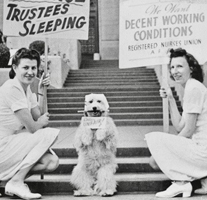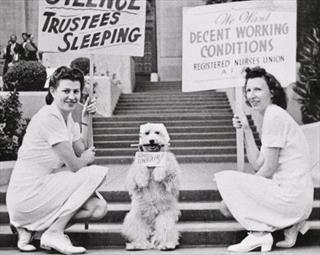

Walter P. Reuther Library Archives of Labor and Urban Affairs, Wayne State University
Nursing unions provide one possible model for veterinary professionals and support staff looking to organize. In this image from SEIU archives, two members of the Registered Nurses Union, circa 1940s, enlist a dog in their action.
News of an effort to unionize veterinary employees came up during the Banfield Pet Healthcare Industry Summit in Portland, Oregon, last week. While it may have been a surprise to some at the gathering, attendees included at least a few who already were involved with the National Veterinary Professionals Union.
With a presence on Facebook and a public website, the movement isn't quite a secret, although a spokeswoman, Liz Hughston, said organizers strive to protect the privacy of those working on the effort who fear retribution from employers.
The stated role of the fledgling union is to collectively bargain and negotiate for better wages and benefits, safer working conditions and more workplace support for employee veterinarians, veterinary technicians, unlicensed assistants, client-care coordinators, reception staff and other unlicensed assistive personnel. Dues are to be determined.
There is no list of contacts on the site. However, Hughston, a registered veterinary technician in the San Francisco Bay Area, serves on the steering committee and acts as the group’s communications director. Hughston identified two other steering committee members: Morgan VanFleet, a licensed veterinary technician based in Seattle who serves as operations director; and Dr. David Gill, a veterinarian, also in Seattle, who focuses on safety issues for the group.
The union emerged early this year with the launch of a unionization effort for veterinary professionals in Washington state, Hughston explained. The state effort was led by VanFleet, who was encouraged to expand regionally and eventually go nationwide.
“People from around the country were saying, ‘What about us? We need a union too,’ ” Hughston said.
She described the early momentum as organic and happening on message boards where veterinary team members, especially technicians and assistants, vented about not being valued for their training or abilities; about being expected to do a lot more with a lot less; and about the challenges of getting by on low salaries — issues that have troubled technicians and other support staff for years.
While employee veterinarians make more money, they, too, face challenges in terms of workplace satisfaction and financial pressures arising from school debt.
“We are all aware that we are never going to make the same as professionals on the human medical side. The economics aren’t there,” Hughston said. “What we want is for people to be able to work in this industry and have a life.”
In the United States, collective bargaining improves pay for employees in many careers, with members earning 5 to 15 percent more on average than their nonunion counterparts, according to a paper by Richard Freeman, an economist at Harvard University, and Kelsey Hilbrich, now a private equity analyst at The Blackstone Group. These estimates don’t factor in pensions, health insurance, vacation time and other benefits.
For veterinary personnel looking to organize, it’s about more than wages, Hughston said. “We’re talking about things like work/life balance, like respecting professional boundaries, like making sure we have safe procedures and protocols in place, that we have safe levels of staffing,” she said. “We want to provide gold-standard levels of patient care. It’s very difficult for most of us to do that, the way the industry is going right now.”
She is referring, in part, to consolidation in veterinary medicine, such as Mars Inc.’s acquisition of VCA, a deal that closed last week, giving Mars ownership of more than 2,000 practices in the United States and Canada. (Mars also owns Banfield Pet Hospital, which sponsored the industry gathering where word of the nascent union surfaced.)
“When a large corporation comes in and buys another large corporation, and now they own 10 percent of the veterinary market, that’s a big deal,” Hughston said. “I think it made those of us working on the ground feel like we were losing even more of the voice and power that we had in the workplace.”
Alongside the effort to spread the word, a core group of volunteers are writing organizational documents and getting paperwork together to file with the National Labor Relations Board to become an officially recognized union. After that, individual workplaces have to unionize themselves.
While rare, unions are not unheard of in veterinary medicine. There is a smattering of unions at private clinics, universities and in research settings. For example, the American Society for the Prevention of Cruelty to Animals has a relationship with a local labor organization representing ASPCA veterinarians at its Animal Hospital and Adoption Center in New York City. Articles in academic journals occasionally explore the case for veterinary unions.
In 2004, some employees at an emergency veterinary hospital in Pennsylvania voted to unionize for better working conditions. Eventually, about a dozen workers went on strike, accusing hospital management of violating the National Labor Relations Act. After three years, the case was resolved in mediation. Striking workers were awarded back pay with interest, and the union — American Federation of State, County and Municipal Employees Local 488 — stepped down from negotiating for the employees.
Those events raised concern from some in the veterinary community who worried unionization would drive up prices to cover higher wages. Dr. Timothy Ireland, then-president of the Pennsylvania Veterinary Medical Association, told the American Animal Hospital Association: “I think this is a wake-up call for those who operate under the assumption that support staff will tolerate injustice because veterinary medicine is a calling, not just a job.” He urged veterinarians to open discussions with employees so they wouldn’t feel the need unionize.
That approach makes sense to Hughston. She predicts that unionizing won't be attractive to a majority of veterinary professionals who work at private practices where they are treated well and comfortable negotiating for themselves.
Moreover, the concept of unionizing is on a downswing. According to the 2013 paper by Freeman and Hilbrich, unions cover a smaller share of private-sector workers than at any other time since 1900. One exception is in the human health-care sector, where the percentage of union workers has climbed steadily during the past decade.
Part of that growth is due to the booming Service Employees International Union (SEIU). Regularly described as one of the most powerful unions in the country, more than half of SEIU’s two million members are hospital, home-care and nursing-home workers. Meanwhile, the 150,000-member National Nurses United has won big victories in fighting for workplace safety initiatives and raising nurse-to-patient ratios. The Economist called nurses "the new autoworkers" in a 2014 blog post.
Hughston sees similarities in the roles of nurses and many veterinary employees, and looks to channel some of their union energy. NVPU founder VanFleet seems even more drawn to the example. According to Hughston, VanFleet is working as a relief veterinary technician while currently attending nursing school.
Edie Lau contributed to this report.